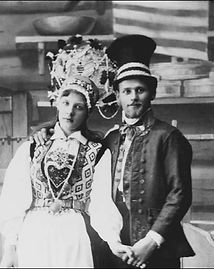

marjo & thomas
WEDDING
1st of March
2014

Valsølille & Hvalsø, DK
The groom will be wearing a morning jacket to the church, while the bride will wear a traditional long wedding gown. Even though according to the etiquette, the morning jacket should be changed into a dark suit or a tuxedo after 6 p.m., the bride and the groom have decided to make an exception to this rule.
For the guests the dress code is formal. This means that while it's good to look polished, you can do it in a less-formal-than-black-tie kind of way. While you can rent something fancy if you want, a sharp-looking suit will do just fine! For ex. dark suit and tie is great for the guys and ladies can wear anything from a long gown to a dressy suit to a formal cocktail-length dress. In the end, what matters most to the bride and the groom is that their guests have a good time - not what they wear!
One more thing - as we'll be dancing until the morning, wear your dancing shoes!
The bridal gown
Brides started to wear white bridal gowns first on the 17th century, white as the symbol of
innosence. The white biral gown became popular first amongst the more wealthy people
while those with less means would continue to wear black wollen or silk dresses long until
the 20th century. From 1778 the brides in Finland, the country being part of the Swedish
kingdom, started wearing a so called swedish national wedding dress, designed by the King
Gustav III by himself. The black wollen dress with a red belt and decorated colar and bib was
designed by the King to bring the nobility and the common people closer to each other. Even
though the nobility quickly got tired of the King's design, this tradition would continue
amongst those with less means and at the countryside in Finland all the way to the 20th
century.
The bridal veil
Books about wedding etiquettes only recommend veil to young women getting married for the first time. In the Nordic countries the tradition for the Brides to wear a veil began in the late 18th/early 19th century, although it would take until the end of the 19th century before also those with less means would take the veil as their own. Before that a bride would wear a crown or a garland.
In the 1800 it was a tradition for the guest to tear the veil to pieces in Denmark. It symbolized that the bride would stop being a virgin now. The more the veil will be torn to pieces – the luckier the bride would be in marriage. For the guests it would bring happiness if the get a piece of the veil. What a relief it is for the brides of today that this tradition is no longer in practise!
Newer bridal traditions
The bride is on her way into a new period of life. Therefore almost everything she is wearing has to be new – though she also has to follow the old English saying;
Something old
Something new
Something borrowed
Something blue
- and a sixpence in your shoe
The old thing have to remind the bride of her former life.
The new thing is a symbol of the new life she is facing.
The borrowed thing should be borrowed from a happily married women - and represents the new family circle she will be a part of.
The blue colour is a symbol of faithfulness and constancy in the marriage.
The coin in her shoe is a sign that the bride never will be short in money.
Many brides in Denmark also wear something red as red is the symbol of love and is said to scare away evil.
Dress code
